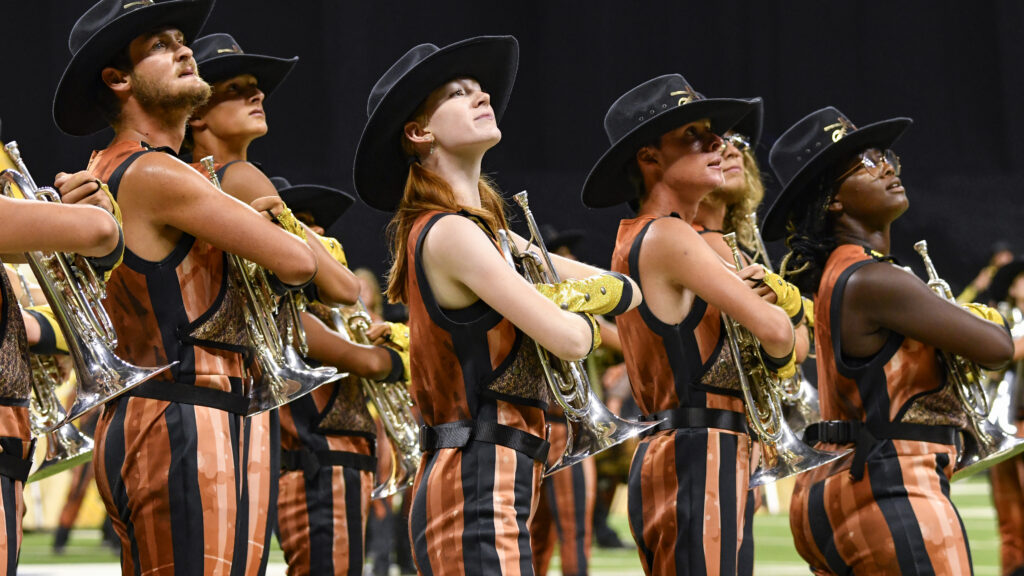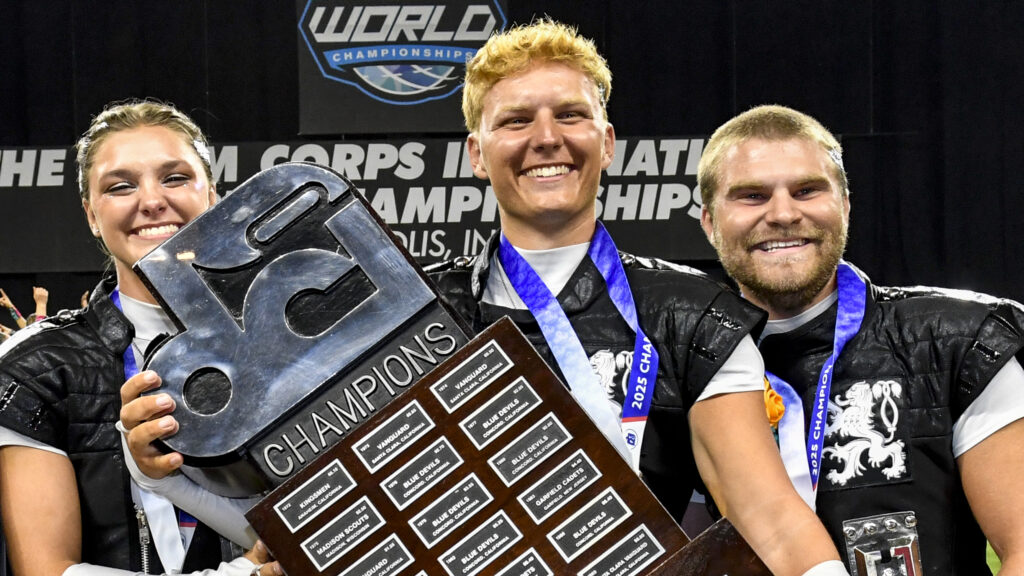
Today we’ll read the reminiscences of Jim Secor, a mellophone player for the corps in 1974 and 1975. Earlier, he played in the Poughkeepsie Vagabonds and Pacers from 1960 through 1971 and the St. Andrew’s Bridgemen in 1972.
Here is Secor’s note: To this day, the word “Hawthorne” evokes memories of one of the greatest junior corps in drum corps history. They were founded in the late 1950s and came into national prominence in the early 1970s. The Muchachos left a legacy that is still a topic of conversation some 25 years after their unfortunate demise. A charter member of DCI in 1972, their ascent to the pinnacle of the drum corps world was swift. Having won the World Open prelims that year, and finishing tenth in DCI’s inaugural season, the future success of the corps was promising. The 1973 season saw continued growth, with an eighth-place finish at DCI finals. But it was the 1974 season that caught the attention of the drum corps world. Winning DCI East, World Open prelims and a host of other shows, the corps saved the best for last, with their best performance at the championships. Anyone who was witness to their finals performance in Ithaca, NY can close their eyes today and hear the deafening roar of the crowd and chants of “East, East, East! It was a drum corps experience that is almost incomparable. The corps finished in fourth, just 2.55 from winning it all. The following day after finals in Syracuse, N.Y., the corps beat the champion Santa Clara Vanguard by almost a point. It was a most-fitting end to a successful season, yet there were greater expectations for the following year. The 1975 Season: Blood, sweat and tears Fresh off the spectacular finish in 1974, the entire corps felt that in 1975 the corps would take its rightful place atop DCI in August. I remember vividly that first rehearsal in November. Looking around the American Legion Hall in Hawthorne and seeing 60-plus horns, we all just had the feeling that we were bound for glory. Our horn instructor, Jeff Kievit, proclaimed that it was our year, and throughout the entire winter, the dedication and focus was something to behold. I can’t remember not being at a rehearsal without a full complement of members, even during the rough winter months. The 1975 show was designed by Frank Gerris, Jim Messina, Jeff Kievit and Dennis DeLucia. Fielding a larger corps for 1975, the show was to be more technically challenging than past years, but would be synonymous with the “powerhouse” corps from the era. The hard work throughout the winter paid off, and as the season opened it was apparent that the corps would be one of the favorites come August. A second place finish at DCI East, .5 from first, and a disappointing fourth against all the “big guns” at the World Open set the stage for the corps’ finest performance to date at the CYO Nationals. A 19.5 in drumming at the CYO event prompted drum judge Gus Barbaro to comment that it was the “finest exhibition in drumming (that he had) ever seen,” highlighted a strong second to the Madison Scouts. The corps put distance between themselves and the Blue Devils, the Santa Clara Vanguard and the 27th Lancers, to set up the showdown in Philadelphia for finals. The Loss of a champion After our showing the previous week in Boston, we were primed for a championship. We tweaked our marching and horn show a bit during finals week, and like everyone else, we just wanted to get on the field to perform. If memory serves me, we had an early afternoon start time for prelims. Our moment had arrived, and the performance was spectacular. I remember coming off the back end of the field, and everyone being excited about the show. As soon as the entire corps was off the field, I noticed DCI executive director Don Pesceone waiting with an entourage (mostly west coast corps directors), then pulling a member of our drum line aside. After a short delay, we went back to the buses, all of us wondering what was happening. It was a short time later that we received the word from our director that the corps had been disqualified for marching with an overage member, and would not be allowed to compete for the championship. It’s hard to explain the sense of loss that we all felt, the pinnacle of success within our grasps, only to see it all disappear in 15 minutes. The night of finals, the entire corps sat in the rear stands watching the performances of the other corps. This was difficult, especially after one judge told us that we had broken the 90-point mark and won prelims over Madison. [Editor’s note: Officially, the corps’ sheets were collected from the judges after the corps performed and were never tabulated.] The only highlight of that weekend was watching Jeff Kievit accept his individual trophy as best soprano player during finals. The following day, we had an exhibition at Hershey Park, Pa. It was the last time many of us would be together or put on a drum corps uniform. The performance was subdued and the incident I’ll remember most is the crowd “booing” when we entered the field, when just a day earlier they couldn’t get enough of us. It was a terrible feeling, yet when we took off our uniform for the last time and said our good-byes to each other, there was such a tremendous sense of pride and accomplishment. The 1976 corps, although somewhat depleted, made a gallant effort to make the top 12, but fell short. A year later the corps was hardly competitive and folded due to lack of funds. So now, after 28 years from that historical performance in Philly, the Muchachos are a part of drum corps history, but are remembered throughout the fraternity. A few short years ago, DCI judge J. Clarke Williams wrote a letter to a Muchachos alumnus about the corps reunion. In that letter is a quote that reads, “I realize that DCI has many negative memories for the Muchachos, but people today still talk about the corps. The legacy of excellence is being passed on.” What more can one ask? As much as one would like to win and enjoy the spirit of competition, the drum corps experience is about much more. It’s about 128 members from all places and walks of life coming together as one to achieve a common goal. It’s about relationships, it’s about family, and it’s about a bond between people that no matter how much time passes, is still as strong today as it was then. It was truly the best times of my life, and the experience is one in which I hope that many more will get a chance to live out. Jim Secor.
Michael Boo has been involved with drum and bugle corps since 1975, when he marched his first of three seasons with the Cavaliers.
He has a bachelor’s degree in music education and a master’s degree in music theory and composition.
He has written about the drum corps activity for over a quarter century for publications such as Drum Corps World, and presently is involved in a variety of projects for Drum Corps International, including souvenir program books, CD liner notes, DCI Update and Web articles, and other endeavors.
Michael currently writes music for a variety of idioms, is a church handbell and vocal choir director, an assistant director of a community band, and a licensed Realtor in the state of Indiana. His other writing projects are for numerous publications, and he has published an honors-winning book on the history of figure skating.
His hobbies include TaeKwonDo and hiking the Indiana Dunes.
But more than anything, Michael is proud to love drum corps and to be a part of the activity in some small way, chronicling various facets of each season for the enjoyment of others.





